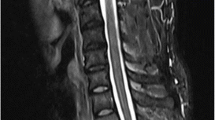Summary
Twenty-eight consecutive patients were given high-dose dexamethasone (96 mg i.v. loading dose, decreasing doses to zero in 14 days) and radiotherapy for epidural spinal cord compression due to malignant disease. There were eight events classified as side effects of the dexamethasone treatment. Four of these were considered as serious (one fatal ulcer with haemmorhage, one rectal bleeding and one gastrointestinal perforation from undetermined origins, and one perforation of the sigmoid colon) giving a total rate of serious side effects of 14.3 percent. Due to the high incidence of serious side effects of the high dexamethasone dose, the regimen was abandoned in favor of a standard dexamethasone dose of 16 mg daily reduced to zero in 14 days. There were three events classified as side effects, but none were considered as serious in 38 consecutive patients receiving this dose. The differences both in total number of side effects and number of serious side effects are statistically significant. There was no significant difference in the number of ambulant patients in the group that received the high dexamethasone dose. We conclude that the high dexamethasone dose in our experience gives an unacceptably high incidence of serious side effects and we have therefore abandoned the regimen in favour of a more standard dexamethasone dose.
Similar content being viewed by others
References
Carabell SC, Goodman RL: Spinal cord compression. In: DeVita (ed) Cancer, Principles and Practice of Oncology. JB Lippincott, Philadelphia, p 1864, 1985
Greenberg HS, Kim JH, Posner JB: Epidural spinal cord compression from metastatic tumor; Results with a new treatment protocol. Ann Neurol 8: 361–366, 1980
Weissman DE, Dufer D, Vogel V, Abeloff MD: Corticosteroid toxicity in neuro-oncology patients. J Neuro-Oncol 5: 125–128, 1987
Fadul CE, Lemann W, Thaler HT, Posner JB: Perforation of the gastrointestinal tract in patients receiving steroids for neurologic disease. Neurology 38: 348–352, 1988
Heimdal K, Watne K, Hirscberg H, Slettebø H, Nome O: Treatment of epidural cord compression. J Norw Med Ass 1991, in press
Vecht CJ, Haaxma-Reiche H, van Putten WLJ, de Visser M, Vries EP, Twijnstra A: Initial bolus of conventional versus high-dose dexamethasone in metastatic spinal cord compression. Neurology 39: 1255–1257, 1989
Delattre JY, Arbit E, Rosenblum MK, Thaler HT, Lau N, Galich JH, Posner JB: High dose versus low dose dexamethasone in experimental epidural spinal cord compression. Neurosurgery 22(6):1005–1007, 1988
Author information
Authors and Affiliations
Rights and permissions
About this article
Cite this article
Heimdal, K., Hirschberg, H., Slettebø, H. et al. High incidence of serious side effects of high-dose dexamethasone treatment in patients with epidural spinal cord compression. J Neuro-Oncol 12, 141–144 (1992). https://doi.org/10.1007/BF00172664
Issue Date:
DOI: https://doi.org/10.1007/BF00172664




